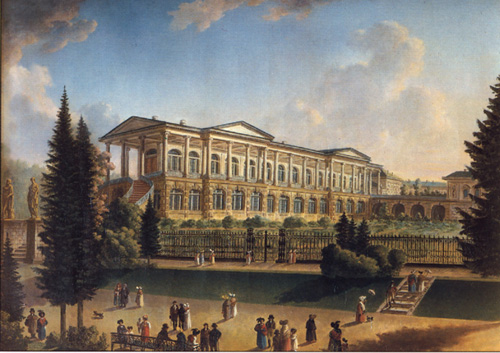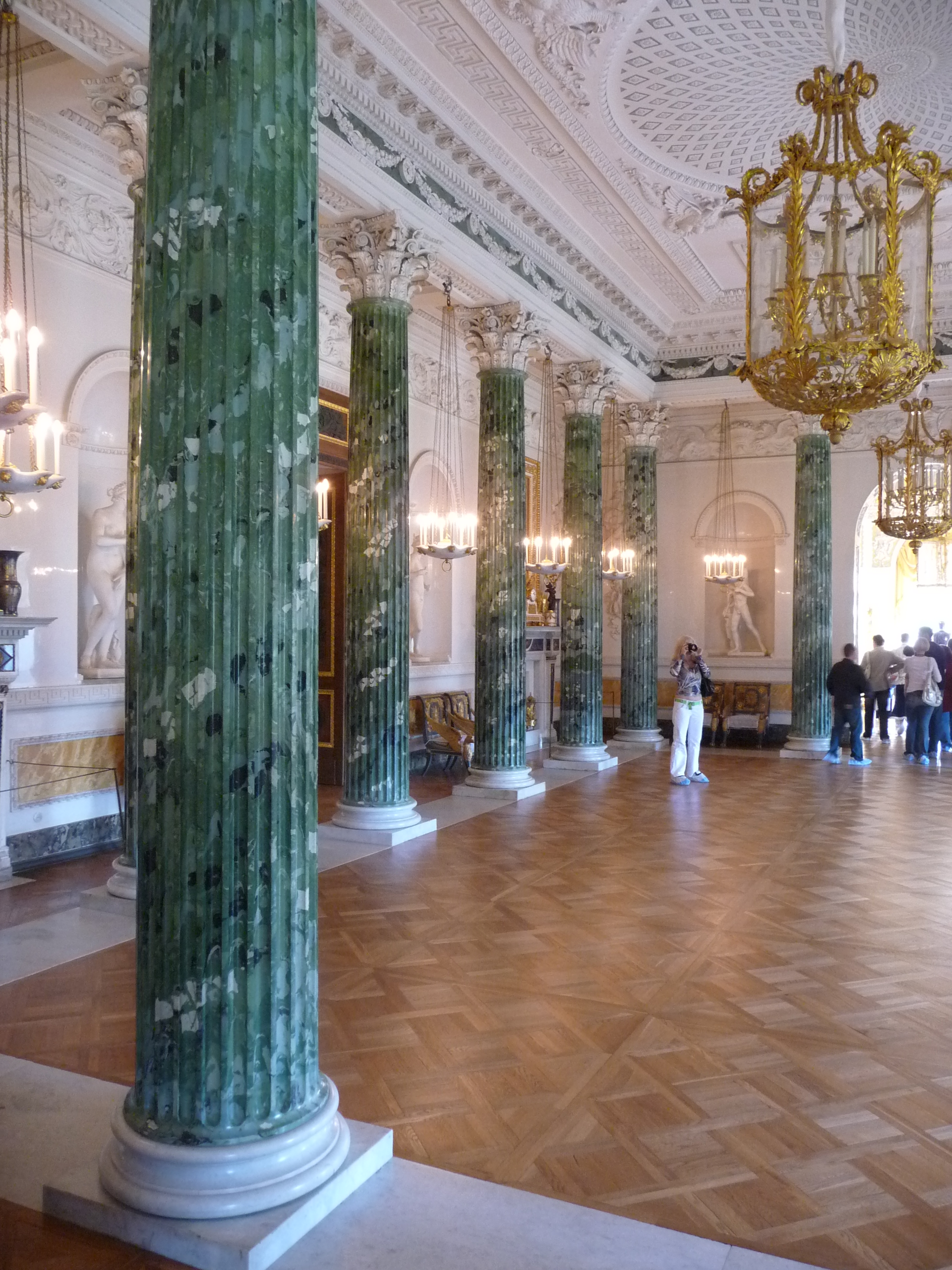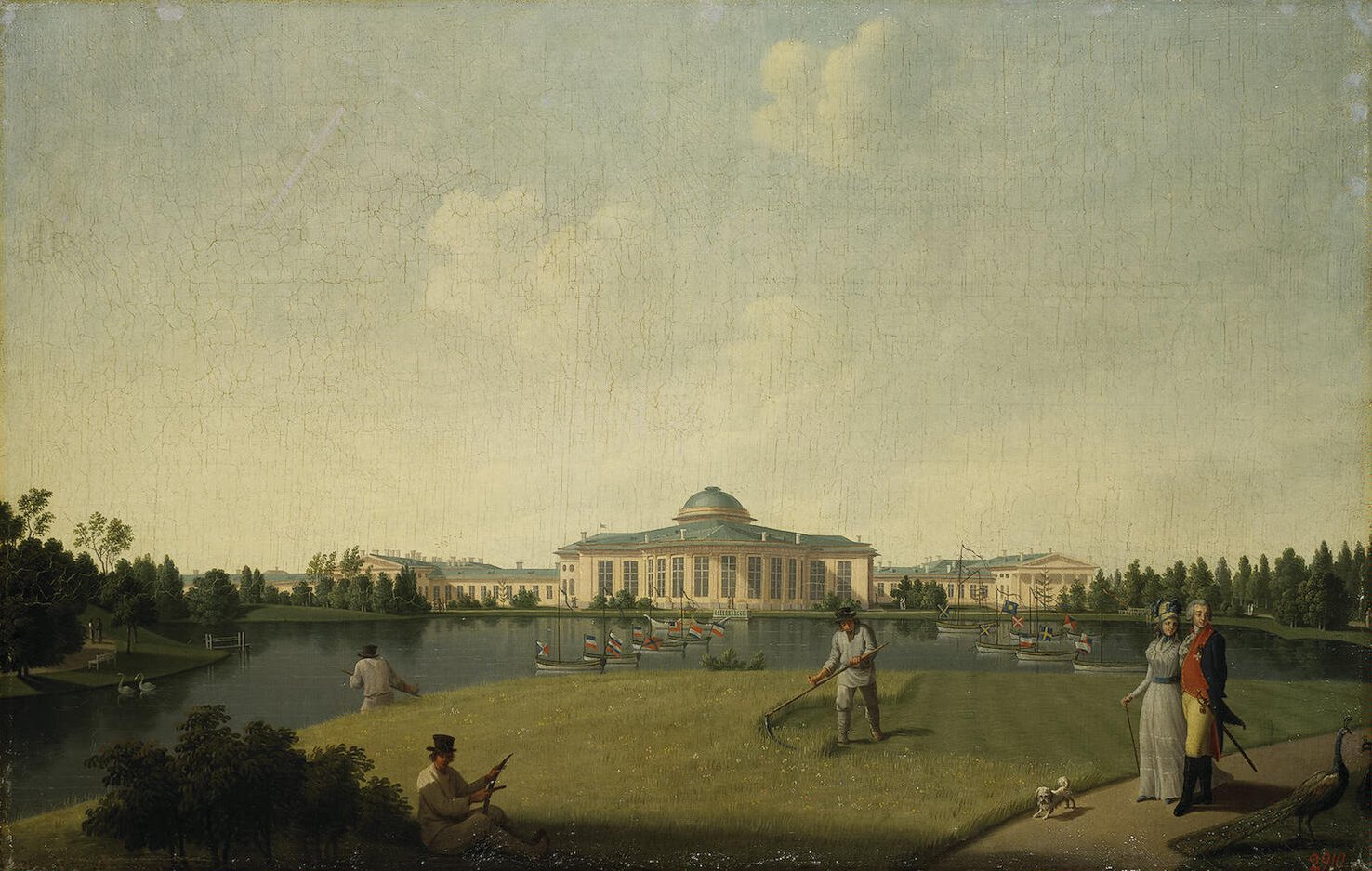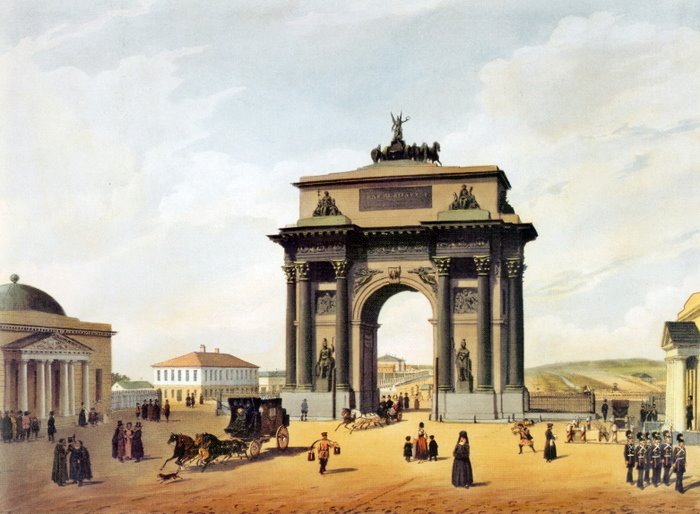Neoclassical Architecture In Russia on:
[Wikipedia]
[Google]
[Amazon]
Neoclassical architecture in Russia developed in the second half of the 18th century, especially after 






 Much of central Moscow was destroyed by fire during the French invasion of 1812. In subsequent decades much of the city was rebuilt in the neoclassical style, under the supervision of Italian-Russian architects such as Joseph Bové, and Alberto Cavos, under military governors Alexander Tormasov (1814–1819) and
Much of central Moscow was destroyed by fire during the French invasion of 1812. In subsequent decades much of the city was rebuilt in the neoclassical style, under the supervision of Italian-Russian architects such as Joseph Bové, and Alberto Cavos, under military governors Alexander Tormasov (1814–1819) and
Catherine the Great
Catherine II. (born Princess Sophie of Anhalt-Zerbst; 2 May 172917 November 1796), most commonly known as Catherine the Great, was the reigning empress of Russia from 1762 to 1796. She came to power after overthrowing her husband, Peter I ...
succeeded to the throne on June 28, 1762, becoming Empress of Russia. Neoclassical architecture
Neoclassical architecture, sometimes referred to as Classical Revival architecture, is an architectural style produced by the Neoclassicism, Neoclassical movement that began in the mid-18th century in Italy, France and Germany. It became one of t ...
developed in many Russian cities, first of all St. Petersburg, which was undergoing its transformation into a modern capital throughout the reign of Catherine II.






Origin of the style
Background
As part of the European cosmopolitan class of the 18th century, Catherine set the tone of Russian social and intellectual life during her long reign. The Catherinian Era was a turning point in terms of the education ofnobility
Nobility is a social class found in many societies that have an aristocracy. It is normally appointed by and ranked immediately below royalty. Nobility has often been an estate of the realm with many exclusive functions and characteristics. T ...
, particularly in the fields of art and literature. French became the court language, and along with the language came the ideas of Enlightenment as well. Her embrace of the neo-classicism current linked her capital to ancient Rome, and this phenomenon was particularly encouraged by poetic allusions to St. Petersburg as similar to the ancient city, and the empress as the goddess Minerva
Minerva (; ; ) is the Roman goddess of wisdom, justice, law, victory, and the sponsor of arts, trade, and strategy. She is also a goddess of warfare, though with a focus on strategic warfare, rather than the violence of gods such as Mars. Be ...
. These Roman references must have galvanized her ideas, finally declaring in a letter to Frau Johanna Dorothea Bielcke (1770):Augustus said that he found Rome built of brick and would leave it built of marble; I say that I found Petersburg virtually wooden and will leave its buildings dressed in marble.Scholars recognize that, regardless of the motivation, Catherine found in architecture an embodiment for her aspirations, particularly the so-called
Greek Project
The Greek Plan or Greek Project (), an early proposed solution to the Eastern question, was advanced by the Russian empress Catherine the Great in the early 1780s. It envisaged the partition of the Ottoman Empire between the Russian Empire, Rus ...
, which aimed to take Istanbul
Istanbul is the List of largest cities and towns in Turkey, largest city in Turkey, constituting the country's economic, cultural, and historical heart. With Demographics of Istanbul, a population over , it is home to 18% of the Demographics ...
to recreate a new "Christian Byzantium". According to William Brumfield, the neoclassical revival in Russian architecture was an "expression of nostalgia for bygone cultural values, and a reformulated sense of imperial monumentality."
The beginnings
In 1762, the Empress had ordered the construction of the palace of Oranienbaum, and on that occasion Antonio Rinaldi had built the Chinese Palace (1762–1768) (which presented a mixture of elements ofBaroque architecture
Baroque architecture is a highly decorative and theatrical style which appeared in Italy in the late 16th century and gradually spread across Europe. It was originally introduced by the Catholic Church, particularly by the Jesuits, as a means to ...
, of classicism and of traditional Chinese architecture), and the pavilion Katalnaya Gorka (with a rollercoaster) (1762–1774). In this cylindrical pavilion, which had 3 branching wings, a dome
A dome () is an architectural element similar to the hollow upper half of a sphere. There is significant overlap with the term cupola, which may also refer to a dome or a structure on top of a dome. The precise definition of a dome has been a m ...
and a triumphal arch
A triumphal arch is a free-standing monumental structure in the shape of an archway with one or more arched passageways, often designed to span a road, and usually standing alone, unconnected to other buildings. In its simplest form, a triumphal ...
with a tower ending in a spire
A spire is a tall, slender, pointed structure on top of a roof of a building or tower, especially at the summit of church steeples. A spire may have a square, circular, or polygonal plan, with a roughly conical or pyramidal shape. Spire ...
, the search for new compositional schemes can be observed. In 1763 Catherine commissioned the French architect Jean-Baptiste Vallin de la Mothe
Jean-Baptiste Michel Vallin de la Mothe (1729 – 7 May 1800) was a French architect whose major career was spent in St. Petersburg, where he became court architect to Catherine II. His students were Ivan Starov and Vasily Bazhenov.
Biogra ...
and the Russian Alexander Kokorinov for the construction of the new headquarters of the Academy of Fine Arts in St. Petersburg. In 1766, De La Mothe became the official court architect.
From 1764, the Academy was directed by the philanthropist and councilor for education of Catherine Ivan Betskoy. In those years, the empress and Betskoy, who had been a regular patron of a public education system in Russia, had conceived the ambitious project to build an orphanage
An orphanage is a residential institution, total institution or group home, devoted to the care of orphans and children who, for various reasons, cannot be cared by their biological families. The parents may be deceased, absent, or abusi ...
in Moscow
Moscow is the Capital city, capital and List of cities and towns in Russia by population, largest city of Russia, standing on the Moskva (river), Moskva River in Central Russia. It has a population estimated at over 13 million residents with ...
. This idealistic experiment, inspired by the Enlightenment movement, was aimed at creating the "ideal citizen" through the recovery of thousands of orphans who were to receive an adequate education. The project of the orphanage
An orphanage is a residential institution, total institution or group home, devoted to the care of orphans and children who, for various reasons, cannot be cared by their biological families. The parents may be deceased, absent, or abusi ...
was given to Karl Blank who, trained at the school of Bartolomeo Rastrelli, was the architect who had built the first neoclassical buildings in Moscow, including said orphanage.
The 1770s: new impulses
In 1773, the Empress wrote a letter to the Academy of France, announcing a contest which asked the architects to design a house in which they were present, at the same time, forms of both Greek and Roman antiquities. Two French academics, Charles de Wailly andCharles-Louis Clérisseau
Charles-Louis Clérisseau (28 August 1721 – 9 January 1820) was a French architect, draughtsman, antiquary, and artist who became a leading authority on ancient Roman architecture and Roman ruins in Italy and France. With his influence extending ...
, sent their drawings, but these were not welcomed positively. Hence, in 1778, Catherine said she wanted to hire two Italian architects, since "the Frenchmen we have here know too much and build dreadful houses – because they know too much." In 1779, she commissioned her ministers, Baron Friedrich Melchior and Johann Friedrich Reiffenstein, who at that time were representatives of the Russian Academy of Arts
Russian Academy of Arts (RAA / rus. РАХ, Росси́йская акаде́мия худо́жеств) is the State scientific Institution of Russian Federation, eligible heir to the USSR Academy of Arts. A founder of RAA is the Governmen ...
of St. Petersburg in Rome, to find the two architects. The same year, two Italians architects, and Giacomo Quarenghi
Giacomo Quarenghi (; , ; 20 or 21 September 1744) was an Italian architect who was the foremost and most prolific practitioner of neoclassical architecture in Imperial Russia, particularly in Saint Petersburg. He brought into vogue an original mo ...
, arrived at the court of Catherine. Within a few years, neoclassicism in Russia, which in its first phase had drawn ideas from the French architecture of the mid-eighteenth century, turned its attention to the interpretive experiences of the Palladian architecture
Palladian architecture is a European architectural style derived from the work of the Venetian architect Andrea Palladio (1508–1580). What is today recognised as Palladian architecture evolved from his concepts of symmetry, perspective and ...
, especially of England and Italy.
The 1780s: Giacomo Quarenghi
At the invitation of Catherine's agents in 1779, Giacomo Quarenghi arrived in St. Petersburg along with the Scottish architect Charles Cameron. He was a renowned neoclassical architect, having studied in Rome withAnton Raphael Mengs
Anton Raphael Mengs (12 March 1728 – 29 June 1779) was a German Neoclassicism, Neoclassical painter.
Early life
Mengs was born on 12 March 1728, at Ústí nad Labem in the Kingdom of Bohemia, the son of Ismael Mengs, a Danish-born painter wh ...
, among other artists and architects who helped shape his interest and expertise in Palladian architecture. Together with Cameron, he first worked on the Catherine Palace
The Catherine Palace (, ) is a Rococo palace in Tsarskoye Selo ( Pushkin), located south of St. Petersburg, Russia. It was the summer residence of the Russian tsars. The palace is part of the World Heritage Site Saint Petersburg and Re ...
located in the Tsarskoye Selo
Tsarskoye Selo (, , ) was the town containing a former residence of the Russian House of Romanov, imperial family and visiting nobility, located south from the center of Saint Petersburg. The residence now forms part of the Pushkin, Saint Peter ...
. Specifically, this entailed the construction of a two-story gallery (''Cameron's Gallery''). Between 1781 and 1796, it was the turn of the palace
A palace is a large residence, often serving as a royal residence or the home for a head of state or another high-ranking dignitary, such as a bishop or archbishop. The word is derived from the Latin name palātium, for Palatine Hill in Rome whi ...
of Paul I in Pavlovsk which, in its original version, became one of the first examples of Palladian
Palladian architecture is a European architectural style derived from the work of the Venetian architect Andrea Palladio (1508–1580). What is today recognised as Palladian architecture evolved from his concepts of symmetry, perspective and ...
villa built in Russia.
But if Cameron had been successful for the display of his fanciful polychrome, the heirs of Catherine Paul
Paul may refer to:
People
* Paul (given name), a given name, including a list of people
* Paul (surname), a list of people
* Paul the Apostle, an apostle who wrote many of the books of the New Testament
* Ray Hildebrand, half of the singing duo ...
and Maria Feodorovna forced him to absolute sobriety, so at Pavlovsk became prominent the use of white and gold. However, Cameron could not comply to the impositions of the new taste. Between 1786 and 1789 Cameron's duties in Pavlovsk passed to the Italian Vincenzo Brenna, hired by Paul in 1782.
In the meantime Quarenghi became the official architect of Catherine II, and between the 1780 and 1785 transformed St. Petersburg into a classical city.
As first assignment, in 1779 Catherine commissioned the architect of Bergamo
Bergamo ( , ; ) is a city in the Alps, alpine Lombardy region of northern Italy, approximately northeast of Milan, and about from the alpine lakes Lake Como, Como and Lake Iseo, Iseo and 70 km (43 mi) from Lake Garda, Garda and Lake ...
the task of introducing the neoclassical style in the Peterhof Palace
The Peterhof Palace ( rus, Петерго́ф, Petergóf, p=pʲɪtʲɪrˈɡof; an emulation of German "Peterhof", meaning "Peter's Court") is a series of palaces and gardens located in Petergof, Saint Petersburg, Russia, commissioned by Peter th ...
. The intervention was performed in the southwest of the '' Top Park '', where he was made the '' English Park '' and in its interior the '' English Palace'', which became the model to which inspire in Russia up to the beginning of 19th century for the villas in the countryside. Between 1782 and 1785 he built the Hermitage Theatre
The Hermitage Theatre ( rus, Эрмитажный Театр, Èrmitážnyj Teátr, ɪrmʲɪˈtaʐnɨj tʲɪˈat(ə)r) in Saint Petersburg, Russia is one of five Hermitage Museum, Hermitage buildings lining the Palace Embankment of the Neva Ri ...
whose interior is inspired by the Teatro Olimpico
The ("Olympic Theatre") is a theatre in Vicenza, northern Italy, constructed in 1580–1585. It was the final design by the Italian Renaissance architect Andrea Palladio and was not completed until after his death. The ''trompe-l'œil'' onstag ...
of Vicenza
Vicenza ( , ; or , archaically ) is a city in northeastern Italy. It is in the Veneto region, at the northern base of the Monte Berico, where it straddles the Bacchiglione, River Bacchiglione. Vicenza is approximately west of Venice and e ...
and for the decorations and the capitals by the ruins of the Theatre of Pompey. Later, between 1787 and 1792, in the Winter Palace
The Winter Palace is a palace in Saint Petersburg that served as the official residence of the House of Romanov, previous emperors, from 1732 to 1917. The palace and its precincts now house the Hermitage Museum. The floor area is 233,345 square ...
Quarenghi had designed and built a place that was the exact replica of the ''Raphael's Loggia'' located in the Apostolic Palace
The Apostolic Palace is the official residence of the Pope, the head of the Catholic Church, located in Vatican City. It is also known as the Papal Palace, the Palace of the Vatican and the Vatican Palace. The Vatican itself refers to the build ...
in Vatican City, here were then inserted the copies of the drawings of the ceilings. Copies of which were commissioned in 1778 by the Empress to von Grimm who, through Reiffenstein, did reproduce in Rome copies of life-sized vault; the encaustic painting
Encaustic painting, also known as hot wax painting, is a form of painting that involves a heated wax medium to which colored pigments have been added. The molten mix is applied to a surface—usually prepared wood, though canvas and other mate ...
s were made by Christoforo Unterperger.
In 1783, Quarenghi designed the Palace of the State Bank on the Griboyedov Canal
The Griboyedov Canal or Kanal Griboyedova () is a canal in Saint Petersburg, constructed in 1739 along the existing ''Krivusha'' river. In 1764–90, the canal was deepened and the banks were reinforced and covered with granite.
The Griboyedov ...
, given the importance of the building, the author gives the monument a majestic appearance. Different was the architect's attitude in the most sober Academy of Sciences (1783–1789) where the outside, unadorned, is marked by a heavy porch in Ionic order
The Ionic order is one of the three canonic classical order, orders of classical architecture, the other two being the Doric order, Doric and the Corinthian order, Corinthian. There are two lesser orders: the Tuscan order, Tuscan (a plainer Doric) ...
and in the inside the elegant proportions and the solemnity of the spaces remind the taste of ancient Rome.
In those years Quarenghi was also busy, after the interventions of the Russian architect Karl Blank and Francesco Camporesi, to complete the Catherine Palace
The Catherine Palace (, ) is a Rococo palace in Tsarskoye Selo ( Pushkin), located south of St. Petersburg, Russia. It was the summer residence of the Russian tsars. The palace is part of the World Heritage Site Saint Petersburg and Re ...
in Moscow (1790–1797).
Quarenghi had built numerous palaces and brought into vogue an original monumental style, of Palladian inspiration, which was a reference for many architects who worked in Russia, among them Ivan Starov
Ivan Yegorovich Starov (; 23 February 1745 – 17 April 1808) was a Russian architect from Saint Petersburg, St. Petersburg who devised the master plans for Yaroslavl, Voronezh, Pskov, Dnipro, Mykolaiv, and many other towns in Russia and Ukr ...
that, for the Prince Potemkin
Prince Grigory Aleksandrovich Potemkin-Tauricheski (A number of dates as late as 1742 have been found on record; the veracity of any one is unlikely to be proved. This is his "official" birth-date as given on his tombstone.) was a Russian mi ...
, created the Tauride Palace. The building, consisting of a main building and two adjoining wings complemented by side pavilions, in perfect adherence to the Palladian villa type, served as a model for innumerable manors scattered across the Russian Empire
The Russian Empire was an empire that spanned most of northern Eurasia from its establishment in November 1721 until the proclamation of the Russian Republic in September 1917. At its height in the late 19th century, it covered about , roughl ...
.
Nikolay Lvov
Nikolay Aleksandrovich Lvov (; May 4, 1753 – December 21, 1803) was a Russian Empire, Russian artist of the Age of Enlightenment. Lvov, an amateur of noble lineage, was a polymathBohlman, p. 45. who contributed to geology, history, graphic arts ...
's architecture represented the second, "strict" generation of neoclassicism
Neoclassicism, also spelled Neo-classicism, emerged as a Western cultural movement in the decorative arts, decorative and visual arts, literature, theatre, music, and architecture that drew inspiration from the art and culture of classical antiq ...
stylistically close to Giacomo Quarenghi
Giacomo Quarenghi (; , ; 20 or 21 September 1744) was an Italian architect who was the foremost and most prolific practitioner of neoclassical architecture in Imperial Russia, particularly in Saint Petersburg. He brought into vogue an original mo ...
. The polymath
A polymath or polyhistor is an individual whose knowledge spans many different subjects, known to draw on complex bodies of knowledge to solve specific problems. Polymaths often prefer a specific context in which to explain their knowledge, ...
architect, among other things, had translated into Russian the treatise '' I quattro libri dell'architettura'' by Palladio
Andrea Palladio ( , ; ; 30 November 1508 – 19 August 1580) was an Italian Renaissance architect active in the Venetian Republic. Palladio, influenced by Roman and Greek architecture, primarily Vitruvius, is widely considered to be one ...
.
The period of Paul I (1796–1801)
Catherine the Great died in 1796, and her son Paul became Emperor; but he had shown signs of mental instability, and it did not last long. His reforms had limited the rights of thenobility
Nobility is a social class found in many societies that have an aristocracy. It is normally appointed by and ranked immediately below royalty. Nobility has often been an estate of the realm with many exclusive functions and characteristics. T ...
, and in 1801 he was assassinated by a group of conspirators, including his son Crown Prince Alexander. The most significant innovation was the change of taste of which the best example has been reflected in the care of the interior of the Pavlovsk Palace
Pavlovsk Palace () is an 18th-century Russian Imperial residence built by the order of Catherine the Great for her son Grand Duke Paul, in Pavlovsk, within Saint Petersburg. After his death, it became the home of his widow, Maria Fe ...
, that the sovereign had chosen as a dwelling. The emperor's wife Maria Feodorovna had tried to introduce into his home the refinements she had known in her visit to France in 1782.Redevelopment post the Moscow Fire of 1812

 Much of central Moscow was destroyed by fire during the French invasion of 1812. In subsequent decades much of the city was rebuilt in the neoclassical style, under the supervision of Italian-Russian architects such as Joseph Bové, and Alberto Cavos, under military governors Alexander Tormasov (1814–1819) and
Much of central Moscow was destroyed by fire during the French invasion of 1812. In subsequent decades much of the city was rebuilt in the neoclassical style, under the supervision of Italian-Russian architects such as Joseph Bové, and Alberto Cavos, under military governors Alexander Tormasov (1814–1819) and Dmitry Golitsyn
Prince Dmitry Vladimirovich Golitsyn (; 29 October 177127 March 1844, Paris) was an Imperial Russian cavalry general prominent during the Napoleonic Wars, statesman and military writer.
Biography
He was born in the Golitsyn family of Knyaz Vl ...
(1820–ca 1840).
Bibliography
* Dmitry Shvidkovsky, ''Russian Architecture and the West'', New Haven (Connecticut),Yale University Press
Yale University Press is the university press of Yale University. It was founded in 1908 by George Parmly Day and Clarence Day, grandsons of Benjamin Day, and became a department of Yale University in 1961, but it remains financially and ope ...
, 2007
* Mario Praz, ''Gusto neoclassico'', Rizzoli, Milano, 1974
* Lionel Kochan, ''The Making of Modern Russia'', London, 1962
* Howard Colvin
Sir Howard Montagu Colvin (15 October 1919 – 27 December 2007) was a British architectural historian who produced two of the most outstanding works of scholarship in his field: ''A Biographical Dictionary of British Architects, 1600–18 ...
, ''A Biographical Dictionary of British Architects, 1600–1840'', 1958; IV edition, Yale University Press, 2008,
* Emil Kaufmann, ''Architecture in the Age of Reason'' – Baroque and Postbaroque in England, Italy, and France, 1955, Harvard University Press
Harvard University Press (HUP) is an academic publishing house established on January 13, 1913, as a division of Harvard University. It is a member of the Association of University Presses. Its director since 2017 is George Andreou.
The pres ...
,
Footnotes
{{DEFAULTSORT:Neoclassical architecture in Russia Architecture in Russia Neoclassical architecture by country